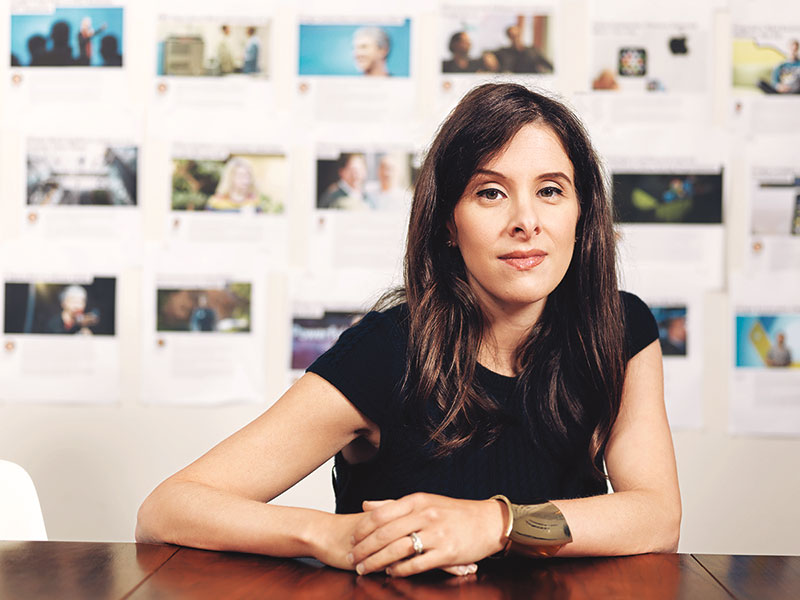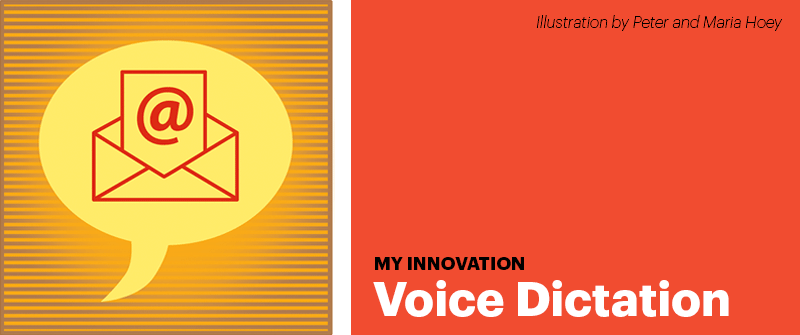On the astro-turfed rooftop of a SoHo penthouse this summer, a mix of tech executives, investors, and B-list celebrities sipped Champagne and nibbled mini tacos served by a white-jacketed waiter. Gayle King, the Oprah confidante and CBS This Morning anchor, was there, admiring the views across Wooster Street to the rest of Manhattan, and talking to Jon Miller, former CEO of AOL.
The crowd was there to pay homage to Jessica Lessin, a 33-year-old former Wall Street Journal reporter, whose tech news site, The Information, could become a new digital model at a time when ad-supported Web news is in need of an economic lifeline.
The Information has gained notice for its contrarian, old-school approach to digital news, which includes a no-joke $399 paywall, relatively scant attention to social media (at least when compared to other digital-first news sites), and a newsroom ethos that encourages reporters to write fewer, deeper stories, as opposed to a constant drip of quick, often thinly reported hits. The Information’s sweet spot is the serious pursuit of business news: Snap Inc.’s IPO plans, the boardroom travails at Uber, an investigation into the founder of Nest Labs.
Success has made Lessin a target of grumbling that she’s too close to the people she’s supposed to be covering.
While The Information isn’t as hot as Vice or BuzzFeed, or as entrenched in digital business reporting as Recode (whose co-founder, Kara Swisher, has been positioned in Silicon Valley as a perhaps-inevitable Lessin rival), the site is clearly making a mark. Its staff now approaches 20 people, it recently opened an Asia bureau, and the number of subscriptions has more than doubled over the past year. It recently announced plans for an expansion that includes an all-access VIP membership for big investors.
Success has won Lessin fans among Silicon Valley’s ruling class, but it has also made her a target of grumbling that she’s too close to the people she’s supposed to be covering, and that the membership model—sparkling with events like the rooftop party—has put her in the odd position of having to hit up for money the very people she should be taking down.
At her Pacific Heights launch party, Valley A-listers included Facebook CEO Mark Zuckerberg, former Twitter CEO Dick Costolo, and Brit + Co founder Brit Morin, who looked on as Lessin, adorned in a gold sequin dress, informed them that The Information would do the stories no one else is doing. “Congrats. I’m so excited about this,” Zuckerberg messaged her on Facebook.
By opting for a subscription business model, Lessin is riding a wave. Politico co-founder Jim VandeHei is going the subscription route for a news start-up for professionals he is incubating and expects to launch early next year. Bernard Gershon, a consultant in the media business, says he now tells content-producing clients to do subscriptions, or at least a subscription hybrid, but never just advertising. “Free is a four-letter word,” he says.
For the $399 a year, or $39 a month, Lessin charges to be part of her club, subscribers get two stories a day and a smorgasbord of networking events around the world (most recently in Bangalore and San Francisco); dinners in trendy restaurants; and parties in fancy homes like the SoHo penthouse of Fox Networks executive Joe Marchese, who says he donated his home because “he’s a fan of The Information and Jessica.” Over the summer, Lessin hosted a screening of Jason Bourne for West Coast subscribers. Members have also been treated to SoulCycle sessions and drinks with her.

Scoops Lessin keeps track of stories that have beat the competition. (Cody Pickens)
Almost three years in, The Information is cash-flow positive, with 10 of the 11 most highly valued tech companies as subscribers. Lessin won’t disclose subscriber numbers beyond saying that they more than doubled over the past year, but observers estimate the site has around 10,000 members, including Valley megastars like Zuckerberg and Snap CEO Evan Spiegel.
Like Recode’s Swisher, Lessin got her start at The Wall Street Journal (where I, too, got to know her). Both women inhabit the upper reaches of the tech world, professionally and socially. But their styles are starkly different in almost every way. While Swisher is brash and brutal—entertainingly so—Lessin is fiercely focused and businesslike. Very public and very fiery feuds trail Swisher (she spent the better part of a decade warring with TechCrunch founder Michael Arrington). Lessin is more sober in her disagreements, never resorting to insults.
Lessin joined Swisher for the first time in Vanity Fair’s New Establishment photo spread last year. In the carefully orchestrated shoot, celebrity photographer Annie Leibovitz positioned Lessin, in a black cocktail dress, in the back row next to 21st Century Fox CEO James Murdoch and Disney CEO Bob Iger.
The Information is housed on the 37th floor of a skyscraper in downtown San Francisco, with spectacular views of the bridge and Alcatraz. The office is modern, and whitewashed, with splashes of bright red on the filing cabinets—not unlike something out of the HBO show Silicon Valley. Reporters (the site has a full-time reporting staff of 10) sit side-by-side with engineers and business-side staffers who handle sales, marketing, and operations.
The previous day, there had been a spike in sign-ups. The operations manager explained they had a double hit: A big company had signed on and a marketing email with links to their Uber scoops had had some success. Next up was an editorial meeting, where they discussed a feature on the rise of free-agent workers in technology, and election-related stories. Lessin popped out to answer a question from the director of engineering, who was testing a new article page. Then it was on to a meeting with the new CMO at venture capital firm Kleiner Perkins to give her sales pitch on The Information. The afternoon was taken up with writing a column, meetings over a new office space, and Skyping with a new recruit in China.
“It’s been a steep learning curve,” says Lessin. “I had no experience of being a CEO, and that’s been the hardest thing about this.”
Lessin has been a journalist since seventh grade, when her English teacher at New Canaan Country School in Connecticut guided her to the school newspaper. When she arrived at Harvard in 2001, she was fully committed to a career in journalism and signed up for duty at The Harvard Crimson.
Zuckerberg was there, a year behind her, but computer science wasn’t hip and she thought her tech-minded boyfriend, Sam Lessin, was “dorky” when he showed off triumphs like getting email on his flip phone. She resisted signing up to thefacebook.com, Zuckerberg’s Facebook precursor at college, until Sam persuaded her she would regret it if she didn’t.
In her senior year, as she was writing her thesis on Walter Lippmann, Lessin landed an internship at the Journal. She graduated on a Thursday and started work the following Monday.
‘Philosophically, Politico and The Information are the same thing,’ says VandeHei.
Technology coverage came almost by accident. As her internship in the economics bureau drew to a close, she sat outside the office of the hiring editor every day in hopes of locking down a full-time job. The persistence paid off. She was offered a position covering consumer technology for the Personal Journal section and soon graduated to covering the industry in San Francisco.
By then, Lessin’s husband-to-be, Sam, had become a fixture on the New York tech scene, and several fellow Harvard alums had become stars in the Valley, including Facebook billionaires Zuckerberg and Dustin Moskovitz, who went on to found Asana. Zuckerberg bought Sam’s start-up Drop.io in 2010 for an undisclosed sum (before its exit, the company had close to $10 million in funding) and hired him as a product manager. Zuckerberg and his wife became close friends of the couple, with Zuckerberg acting as a groomsman at their Carmel wedding in 2012.
Lessin’s connections caused friction at times. She was caught off guard early on at the Journal when Gawker, the now-defunct gossip site, got hold of a video in 2008 that she and some tech industry friends had made lip-syncing to Journey’s “Don’t Stop Believin’” during a vacation to Cyprus. Gawker slapped her for getting too close to the industry she covered.
Accusations of coziness appear to have had an effect on Lessin. She is careful not to flaunt her connections, even to her staff, and was especially tight-lipped about her wedding at the Journal, although Business Insider got wind of the Who’s Who guest list and ran a piece titled “A Facebook Executive’s Wedding Was the Tech Networking Event of the Year.” A look at Lessin’s Facebook feed these days reveals a meticulously polished image, focusing mostly on stories from The Information, work events, and staff anniversaries, peppered with the occasional G-rated shot of her family and pasttimes such as kite-surfing, cliff jumping, and tennis.
It is a tricky balance for any of the new subscription-model services: When your business depends on creating a tight sense of community, often with the people you’re writing about, finding the right mix of a closed club and an aggressive reporting culture can take time. Politico, for instance, has long been dogged by complaints about the incestuous ways it covers Washington, even though it clearly has changed the nature of political reporting and landed far more than its share of notable, and aggressive, scoops.
Lessin argues the scrutiny over her connections is inevitable for anyone who has been covering an industry for years. “It doesn’t bother me,” she says, adding that her coverage is tough where it needs to be. “If you don’t write the stories subscribers know to be true and tough, it’s bad for business. You earn respect by being tough, not writing puff pieces.”

Next The Information is adding bureaus and is in constant hiring mode. (Cody Pickens)
It was Lessin’s frustrations as a journalist at a traditional publication that got her thinking about launching her own venture. Even as her star was rising at the WSJ, which was grappling with its own digital and paywall issues, Lessin spent evenings with her husband batting around ideas about the potential for a better journalistic business model. Beat reporters (herself included) were being torn in multiple directions and less time and emphasis were being placed on high-value, high-impact stories.
Lessin became fascinated by Politico and its ability to build a loyal audience willing to pay for content. Despite the intense amount of free technology coverage, from Business Insider and TechCrunch to Gigaom and PandoDaily, she believed there was an opening for something like Politico in tech.
“At the time, there weren’t a lot of people thinking about the business of journalism the way we do,” says VandeHei. “Back then, most people were looking at trying to get as much traffic as humanly possible. We shared a view that you would be better off focusing on specific audiences and offering them content they’ll cherish and they’ll gladly pay for.…Philosophically, Politico and The Information are the same thing.”
VandeHei is a critic of what he calls the “crap trap” of digital media companies producing “trashy clickbait,” and is convinced that model will get washed away as audiences demand more consequence and value.
That doesn’t mean all digital advertising models are flops. The Atlantic Media-backed news site Quartz has built a sustainable business based on display and native advertising, events, and sponsorships. The site had 20 million unique visitors in July and employs around 100 journalists. Advertising Age reported in July that Quartz was on track to bring in more than $30 million in revenue this year, suggesting it is likely to at least break even.
But others have faltered. Well-respected tech site Gigaom was forced to shutter after over-extending itself in a race for scale. Mashable cut back its staff, replaced its top editor, and slimmed down its coverage as it shifted its focus to video. Swisher’s Recode, which has an enviable event business but relies on advertising for its website, sold out to Vox after conceding that “everybody is bigger than us.”
VandeHei is convinced Lessin is on the right track, though he thinks she should have been more aggressive on price. “There isn’t much difference between $400 and $800. For a mid-range subscription, price is more elastic than people think,” he says.
Lessin says she wanted to start out at a price that felt premium but not one that put her in the realm of pricey but narrowly focused research newsletters. “At that price, you’re missing out on a group of professionals who are broadly interested, who are smart, but not super specialized,” she says. “A price of $399 a year was close to a fully loaded subscription at the WSJ, which felt about right.”
But she jacked up the price, Politico-style, for a new invitation-only subscription for professional investors, including hedge funds, VCs, and private equity managers. For $10,000 a year, these subscribers will get more access to the reporting team, with private monthly conference calls and in-person briefings.
Lessin used family money to start the business and retains full ownership. Her funding model has given her more independence, and less conflict, than most. There are no venture capitalists to answer to or media partners to work with.
She declines to say how much she invested but says it wasn’t “tens of millions of dollars….I’m not bank-rolling huge checks,” she says.
Quartz Editor in Chief Kevin Delaney believes that part of the special sauce for both his and Lessin’s companies is that “neither business is venture-funded but both are cash rich, and both started with conservative funding and disciplined spending.”
Lessin turned to Delaney, another former Journal colleague, for advice on how to get her subscription business off the ground. “It’s hard to get momentum,” he recalls telling her. They talked about building concentric circles of subscribers, with the core circle being the Silicon Valley community she knew well. “Friends, and friends of friends. She needed to go out to the 1,000 people she knew to make a go of it. She was confident she had that,” he says.
Lessin picked six individuals in tech and finance, ranging from entrepreneurs to hedge funders, whom she thought represented her core subscriber. She grilled them on the type of coverage they wanted and used them as a reference to mold the new service.
Based on those conversations, she devised a coverage plan: The Information would focus on exclusive stories and deep-dive or data-driven analysis. She left the constant stream of commoditized news emanating from the PR machines of the big tech companies to the hordes of other tech reporters.
Drawing on the experience of friends like Hayley Barna, who co-founded the cosmetics subscription service Birchbox, she also resolved to build a community around her subscribers, with events and a forum for their comments, as well as a subscriber-only Slack channel.
Her biggest and most time-consuming challenge has been finding talent who can pull off those kinds of stories and also co-exist in a start-up culture.
She turned to the WSJ for several key hires: Her current managing editor is former WSJ veteran Martin Peers, and two of her star reporters, Amir Efrati and Reed Albergotti, came from there. Offering competitive salaries, she also hired from Fortune, Reuters, and the Los Angeles Business Journal, among others. The automatic sign-off at the end of her emails reads hopefully: “The Information is hiring.
The rap on a subscription-model business is that it is hard to scale.
Not all her hires have worked out. Several employees, including former Industry Standard Editor in Chief Jonathan Weber (now at Thomson Reuters), Katie Benner (now at The New York Times), Eric Newcomer (now at Bloomberg) and one of the site’s first engineers, Pius Uzamere, made exited early on. While the team bonded over long hours spent huddled in cramped quarters in those early days, at least some of them struggled to adapt to Lessin’s style of management, which hails from the editor-centric WSJ, where top-down leadership is part of the culture. (Lessin acknowledges that it took time to work out who was a good fit for The Information, and concedes that managing a team was a learning curve for her.)
In terms of coverage, The Information has had its fair share of scoops and notable stories. While it hasn’t been throwing bombs on the scale of the WSJ’s Theranos coverage, it has earned a reputation for being appropriately tough.
The investigation into Tony Fadell, the founder of Nest, is an example. The 4,000-word story, by Albergotti, unravelled the micro-managing style of the Silicon Valley star, who created a sensation with his smart home products and sold his business to Google two years ago. A Nest executive accused him of acting like a “tyrant bureaucrat,” according to the story, and his management style was cited as one reason the much-hyped company had failed to launch new products. When the story was posted, it crashed The Information’s site. Fadell later announced he was stepping down.
The rap on a subscription-model business is that it’s hard to scale because of the narrow focus needed to make it work in the first place. Lessin points to publishers like the WSJ and The Financial Times, which have made paywalls work on a large scale. “You have to become indispensable to a core audience first and then find related or adjacent audiences,” she says. “It’s still the early days.”
Lessin recently formed a six-person advisory board to help navigate the next stages of growth, including VandeHei, venture capitalist John Doerr, and ProPublica Executive Chairman Paul Steiger. After leaving his job at Facebook in 2014 to get back to the start-up world, Sam Lessin is now more involved. Holding the official title of “intern” (“because it’s the best job in the world”), he writes a weekly column and is on hand for advice.
The question now is how to grow from here. The Silicon Valley audience of tech decision-makers is arguably the easiest subscriber group to lock down. Lessin has identified fintech, biotech and media for the next wave. Geographically, New York and Los Angeles are on her radar, as are emerging tech epicenters such as Austin, Denver, Boulder, and Salt Lake City. Further afield, she has plans for Asia.
On a trip to China in March, Lessin looked for expansion opportunities. Subscribers have been asking for more global coverage, particularly in China, where there are fewer reporters on the ground writing smartly about tech. During her trip she scored a key hire: former WSJ reporter Shai Oster.

(Cody Pickens)
Ahead of time, she sent subscribers an email inviting a small number “to join me for a special opportunity for exclusive, on-the-ground access to technology leaders in Beijing.” A group from the US, the UK, and parts of Asia signed up for the trip (which was only available to annual, rather than monthly, subscribers and required them to pay their own way) and met with counterparts at electronics company Xiaomi, venture capital firm Shunwei Capital, investment management firm Hillhouse Capital Group, and others.
On her return, Lessin experimented with another new format to connect with subscribers—a conference call to talk about their trip. Standing in a friend’s kitchen between meetings, she waited nervously to see if anyone would join the call. Hundreds did, with 85 percent staying more than an hour, she says. “It was definitely one of those moments when the lightbulb goes off and you know you’re onto something there’s demand for.”
More reporters mean more stories, which subscribers would welcome. Unlike her rivals, she has decided against seeking a new revenue stream by joining the crowded field for big-ticket events, like the Code conference, which starts at $6,500 a ticket. While she has a full plate of events, they are more informal and don’t take as much effort. Instead, she is rolling out two new subscriptions: The high-end one for professionals and a discounted one for students.
At her annual San Francisco summit for subscribers last month, Lessin said she was confident she could keep up or accelerate the recent rate of subscriber growth and announced plans for the biggest tech reporting team in the Bay area within a year.
For now, she plans to fund growth through new subscriptions and her own money. But she’s not closing the door to other options down the road.
“We are pretty ambitious and we don’t want to close off an opportunity because it means joining up with an investor,” says Lessin. “But it would have to be a case of an investor helping us go after a big opportunity we couldn’t go after alone.”

Of all the tech services that have made my life easier, one stands above the rest: voice dictation. By pressing the microphone on my iPhone keyboard and speaking a few sentences, I can send emails about twice as fast as before. I also use voice to enter commands and addresses into apps. The technology is improving rapidly. The annoying typos that were common a year ago have vanished, and the feature understands punctuation and capital letters. I don’t drive much, but if I did, hands-free typing would be a lifesaver. As it is, it makes my walks to and from work way more productive.


